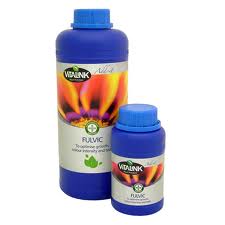Fulvic Acid – helps nutrient uptake and is a nutrient transporter for faster results when feeding tomatoes.
What is Fulvic Acid?
It is a natural product from nature that improves the way plants transport food.
It can be given at each stage of growth, from seedlings through to fruiting plants and will maximise the efficiency of all nutrients that are available in the soil, or given to plants out of a packet.
Fulvic acid can be fed to roots or applied as a foliar spray – either way it starts work immediately and improves results all-round.
Fulvic Acid May Help Avoid Blossom End Rot
One particular advantage is that it may help transport calcium around a plant’s system to where it is needed, helping to avoid Blossom End Rot.
Some minerals such as nitrogen and magnesium are freely available around a plant’s system. This means that when called on, nitrogen can be moved from lower leaves to upper leaves and is one reason why lower leaves often turn yellow as they give (transport) their nitrogen to leaves higher-up the plant.
Calcium is normally an immobile element which means “where it goes it stays”.
When the tomatoes are growing, if there is not enough calcium available via the roots or from a direct foliar application, the tomatoes won’t receive enough calcium and are unable to develop fully – Blossom End Rot is the result.
However, fulvic acid may help calcium to be moved around a plant more easily and helps plants to move nutrients to where they are needed.
When nutrients are available to a plant, in the amounts required, growth is quick and healthy.
These are some of the many benefits of using a fulvic acid. Find out more at this link:
http://www.vitalink.eu/additives/fulvic/



Steve Penn
Hi Nick,I live in southern spain and I´m growing moneymakers in pots! The plants are very healthy, with plenty of greenery and producing a ´fair crop`of fruit, but a considerable amount of the flowers are not developing into tomato´s, the flowers seem to just die off. Do you have any ideas to prevent or reduce this.I´m watering in the evening and feeding every couple of days now. Thanks for any help you can give and enjoy reading and the tips in the newsletters. Best regards s.penn
John Taylor
Hi Nick – First of all thank you for your very helpful site.
Please can you advise? My tomato plants are in my allotment. Can I use WELL rotted horse manure as a mulch?
Thanks John
Rhys Jaggar
Great tip Nick.
I’ve managed to avoid blossom end rot by taking about 6 eggshells, putting them in a food mixer for a minute or so and spooning some of the crushed shells onto the surface of the tomato pot. Doing this at the beginning of each month seems to keep them healthy (well, it did last year, anyway).
This sounds like another great addition to the mix. Are there any naturally occurring sources (would a comfrey tea, a chamomile tea or the like have any in it)?
Nick
Hi Rhys,
Thanks for all your comments and updates!
Fulvic and Humic acids are found in humus – organic matter such as peat and coal. I’m not sure if it can be obtained by making an organic tea of some kind, but I will keep the idea in mind and get back to you if I discover something.
Regards,
Nick